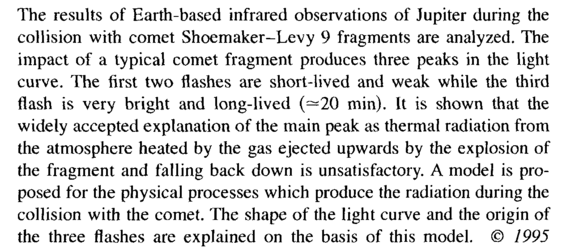Collision of a comet with Jupiter: Light curve fine structure
Fortov V. E. , Ivlev A. V., Klumov B. A.
The results of Earth-based infrared observations of Jupiter during the collision with comet Shoemaker-Levy 9 fragments are analyzed. The impact of a typical comet fragment produces three peaks in the light curve. The first two flashes are short-lived and weak while the third flash is very bright and long-lived (==20 min). It is shown that the widely accepted explanation of the main peak as thermal radiation from the atmosphere heated by the gas ejected upwards by the explosion of the fragment and falling back down is unsatisfactory. A model is proposed for the physical processes which produce the radiation during the collision with the comet. The shape of the light curve and the origin of the three flashes are explained on the basis of this model. © 1995


